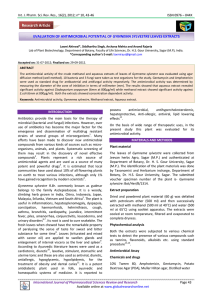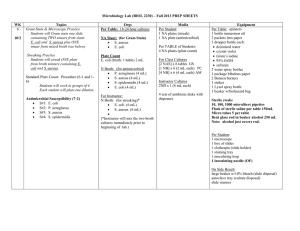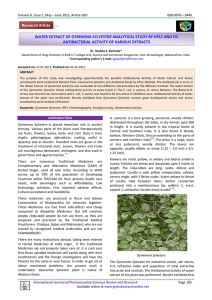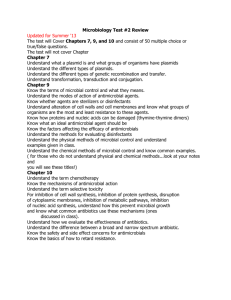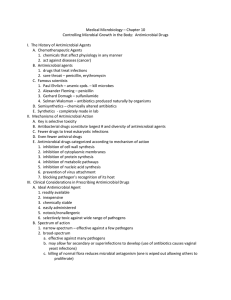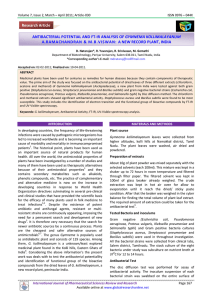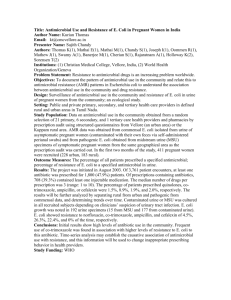Document 13310286
advertisement
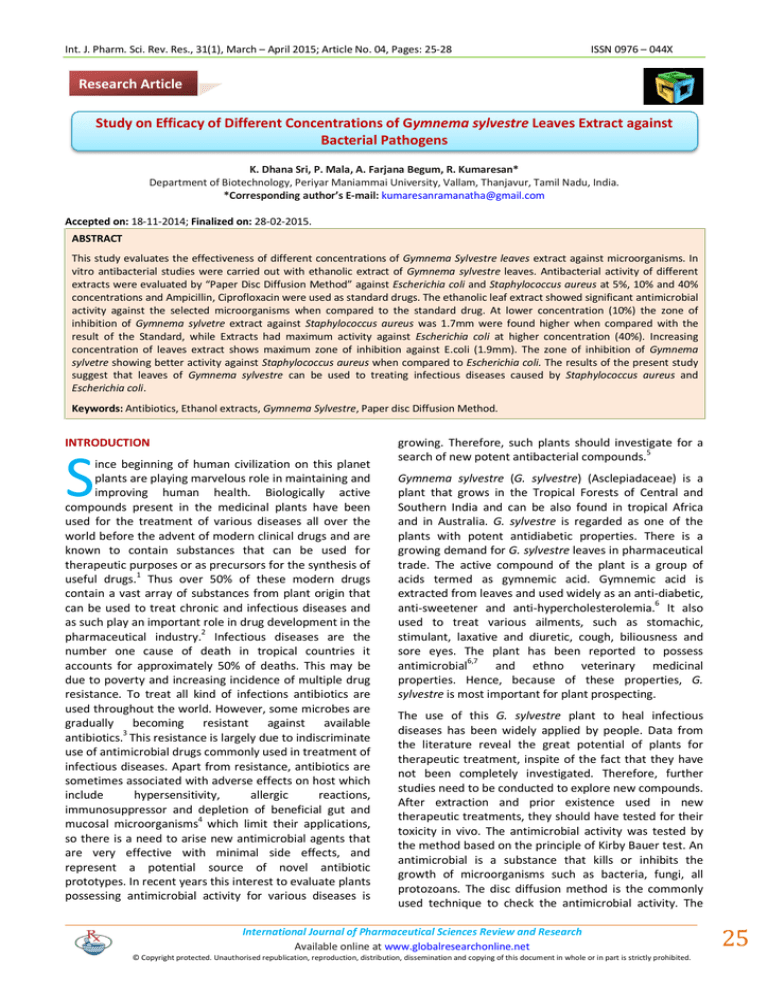
Int. J. Pharm. Sci. Rev. Res., 31(1), March – April 2015; Article No. 04, Pages: 25-28 ISSN 0976 – 044X Research Article Study on Efficacy of Different Concentrations of Gymnema sylvestre Leaves Extract against Bacterial Pathogens K. Dhana Sri, P. Mala, A. Farjana Begum, R. Kumaresan* Department of Biotechnology, Periyar Maniammai University, Vallam, Thanjavur, Tamil Nadu, India. *Corresponding author’s E-mail: kumaresanramanatha@gmail.com Accepted on: 18-11-2014; Finalized on: 28-02-2015. ABSTRACT This study evaluates the effectiveness of different concentrations of Gymnema Sylvestre leaves extract against microorganisms. In vitro antibacterial studies were carried out with ethanolic extract of Gymnema sylvestre leaves. Antibacterial activity of different extracts were evaluated by “Paper Disc Diffusion Method” against Escherichia coli and Staphylococcus aureus at 5%, 10% and 40% concentrations and Ampicillin, Ciprofloxacin were used as standard drugs. The ethanolic leaf extract showed significant antimicrobial activity against the selected microorganisms when compared to the standard drug. At lower concentration (10%) the zone of inhibition of Gymnema sylvetre extract against Staphylococcus aureus was 1.7mm were found higher when compared with the result of the Standard, while Extracts had maximum activity against Escherichia coli at higher concentration (40%). Increasing concentration of leaves extract shows maximum zone of inhibition against E.coli (1.9mm). The zone of inhibition of Gymnema sylvetre showing better activity against Staphylococcus aureus when compared to Escherichia coli. The results of the present study suggest that leaves of Gymnema sylvestre can be used to treating infectious diseases caused by Staphylococcus aureus and Escherichia coli. Keywords: Antibiotics, Ethanol extracts, Gymnema Sylvestre, Paper disc Diffusion Method. INTRODUCTION S ince beginning of human civilization on this planet plants are playing marvelous role in maintaining and improving human health. Biologically active compounds present in the medicinal plants have been used for the treatment of various diseases all over the world before the advent of modern clinical drugs and are known to contain substances that can be used for therapeutic purposes or as precursors for the synthesis of useful drugs.1 Thus over 50% of these modern drugs contain a vast array of substances from plant origin that can be used to treat chronic and infectious diseases and as such play an important role in drug development in the pharmaceutical industry.2 Infectious diseases are the number one cause of death in tropical countries it accounts for approximately 50% of deaths. This may be due to poverty and increasing incidence of multiple drug resistance. To treat all kind of infections antibiotics are used throughout the world. However, some microbes are gradually becoming resistant against available antibiotics.3 This resistance is largely due to indiscriminate use of antimicrobial drugs commonly used in treatment of infectious diseases. Apart from resistance, antibiotics are sometimes associated with adverse effects on host which include hypersensitivity, allergic reactions, immunosuppressor and depletion of beneficial gut and 4 mucosal microorganisms which limit their applications, so there is a need to arise new antimicrobial agents that are very effective with minimal side effects, and represent a potential source of novel antibiotic prototypes. In recent years this interest to evaluate plants possessing antimicrobial activity for various diseases is growing. Therefore, such plants should investigate for a search of new potent antibacterial compounds.5 Gymnema sylvestre (G. sylvestre) (Asclepiadaceae) is a plant that grows in the Tropical Forests of Central and Southern India and can be also found in tropical Africa and in Australia. G. sylvestre is regarded as one of the plants with potent antidiabetic properties. There is a growing demand for G. sylvestre leaves in pharmaceutical trade. The active compound of the plant is a group of acids termed as gymnemic acid. Gymnemic acid is extracted from leaves and used widely as an anti-diabetic, anti-sweetener and anti-hypercholesterolemia.6 It also used to treat various ailments, such as stomachic, stimulant, laxative and diuretic, cough, biliousness and sore eyes. The plant has been reported to possess 6,7 antimicrobial and ethno veterinary medicinal properties. Hence, because of these properties, G. sylvestre is most important for plant prospecting. The use of this G. sylvestre plant to heal infectious diseases has been widely applied by people. Data from the literature reveal the great potential of plants for therapeutic treatment, inspite of the fact that they have not been completely investigated. Therefore, further studies need to be conducted to explore new compounds. After extraction and prior existence used in new therapeutic treatments, they should have tested for their toxicity in vivo. The antimicrobial activity was tested by the method based on the principle of Kirby Bauer test. An antimicrobial is a substance that kills or inhibits the growth of microorganisms such as bacteria, fungi, all protozoans. The disc diffusion method is the commonly used technique to check the antimicrobial activity. The International Journal of Pharmaceutical Sciences Review and Research Available online at www.globalresearchonline.net © Copyright protected. Unauthorised republication, reproduction, distribution, dissemination and copying of this document in whole or in part is strictly prohibited. 25 © Copyright pro Int. J. Pharm. Sci. Rev. Res., 31(1), March – April 2015; Article No. 04, Pages: 25-28 basis of growth of a microorganism on the inoculated plate begins at the point distant from the crude extract reservoir and proceeds inwards until a points reached where the concentration of crude extract is inhibitory for 8 the organisms. E.coli is gram negative bacteria that are usually found in the gastro-intestinal tracts of warm blooded organisms. The most common cause of urinary tract infection in humans is E. coli, causing a various types of gastrointestinal diseases in humans. Stephylococus aureus is a gram-positive, non spore forming bacteria belongs to staphylococcus genus. In the present study, the choice of this plant for evaluation was based on its traditional usages. The main purpose of the current study was to assess the inhibitory activities of selected medicinal plants against some human pathogenic microbes that cause infection. MATERIALS AND METHODS Collection of Plant Materials The G. sylvestre were leaves collected in and around manargudi, Tamilnadu and authenticated. Fresh materials (leaves) were washed under running tap water, air dried and then ground into fine powder. The powder was stored in airtight bottles until required for further analysis. Preparation of extracts The leaves of Gymnema sylvestre were collected. The collected Plant Material (Leaf) was shade dried at room temperature and fine powder is obtained by grinding and sieving. The powered leaves material were accurately weighed and subjected to solvent extraction. The 10g dried powder of the leaves was allowed to Soxhlet for extraction with ethanol. After extraction, the excess solvent from the extract was distilled out using a distillation apparatus. The extract was collected, filtered through Whatman filter paper no. 1. and evaporated to dryness. A semisolid or dried crude extracts of leaves so obtained was re-suspended in an inert solvent, DMSO. The extracts were preserved in airtight containers and o kept at 4-5 C until further use. Stock solution Stock solution of leaf extract was prepared in DMSO from which different concentrations of leaf extract were prepared viz., 5%, 10%, 15%, and 40% and control respectively.9 Test organisms and culture conditions The bacterial strains used to evaluate the antimicrobial properties of extracts of Gymnema sylvestre includes Staphylococcus aureus (Gram positive bacteria), Escherichia coli (Gram negative bacteria). The stock cultures used in the study were obtained from Institute of Microbial Technology (IMTECH), Chandigarh, India. The standard Nutrient agar (Himedia, India.) was used as the ISSN 0976 – 044X media for the culturing of bacterial strains. Culture was maintained on Nutrient agar slant at 4oC and subcultured every three days. Antibacterial activity The microbial growth inhibitory potential of the G. sylvestre leaves extracts were determined by using the agar Disc diffusion method. 250 ml of nutrient agar medium was taken in the conical flask. Then the media was autoclaved at 121°C for 20 minutes. Approximately 20 mL of molten and cooled media was poured in sterilized petridishes. The plates were left at room temperature for 12 h to check for any contamination to appear. Loops full of the microbial cultures (S. aureus and E.coli) were inoculated in the nutrient Agar plates and incubated at 37°C for 24 h. Leaves extracts were used in different concentrations to evaluate the antimicrobial properties. Different concentrations of the extracts were prepared (i.e. 5%, 10%, 15%, and 40%) with DMSO. Paper discs were prepared from Whatman Filter Paper and the paper discs were dipped in these concentrations of extract for 5 min. The paper discs impregnated with tested extracts were placed on solidified mediums. Then the standard disc cephalosporin was placed in the medium inoculated with S. aureus and Ampicillin placed on the medium inoculated with E.coli at different locations. The plates were incubated at room temperature 37°C for 24 hrs. The plates were examined for evidence of zones of inhibition, which noticeable as a clear area around the disc. The diameter of such zones of inhibition was measured using a meter ruler and the mean value for each organism was recorded and expressed in millimeter.10 RESULTS AND DISCUSSION In the present study the antimicrobial activity of leaf extracts at various concentrations was evaluated against two test spp (S. aureus and E.coli) are presented in Table. In the first stage the leaf extracts of G. sylvestre at different concentration (i.e. 5%, 10%, 15%, and 40%) was applied on plates of each test strains. The inhibitory activities of the leaf extracts against E. coli reported in the present study were compared with standard antimicrobic Ampicillin. Similarly anti bacterial activities of the leaf extracts against S. aureus also compared with standard antimicrobic Ciprofloxacin. At 5% concentration, both leaf extract and Ampicillin did not show significant antimicrobial effect on E.coli strains. The zone of inhibition of standard antibiotic Ampicillin (10% and 40%) against E.coli was 0.7mm, 0.6mm. At the same concentration, sample showed significant antimicrobial activity against E. coli. Zone of inhibition of the sample against E.coli was 1.5mm, 1.9mm. At lower concentration (5%), both leaf extract and ciprofloxacin showed mild to moderate activity against S. aureus. The zone of inhibition of standard antibiotic ciprofloxacin was 0.7mm.On comparison to standard, Zone of inhibition of sample showed higher activity against S. aureus. It was International Journal of Pharmaceutical Sciences Review and Research Available online at www.globalresearchonline.net © Copyright protected. Unauthorised republication, reproduction, distribution, dissemination and copying of this document in whole or in part is strictly prohibited. 26 © Copyright pro Int. J. Pharm. Sci. Rev. Res., 31(1), March – April 2015; Article No. 04, Pages: 25-28 measured to be 1.2 mm. higher concentrations of antibiotic and sample (10%) showed maximum inhibition against Staphylococcus aureus. The zone of inhibition of ISSN 0976 – 044X sample against Staphylococcus aureus was 1.7 mm, antibiotic was 0.7 mm which is less compared to antibacterial activity of sample. Table 1: Antimicrobial activity of Gymnema sylvestre leaf extracts of the zone of inhibition the sample and antibiotic in different concentrations Test Organism Antibiotics Diameter of the zone in the Antibiotic of concentration (cm) Diameter of the zone in the sample of concentration (cm) 5% 10% 40% 5% 10% 40% Escherichia coli Ampicillin - 0.7 0.6 - 1.5 1.9 Staphylococcus aureus Ciprofloxacin 0.5 0.7 - 1.2 1.7 - The maximum zone of inhibition of sample against Staphylococcus aureus was 1.7 mm at 10% concentration, but zone of inhibition of the sample Gymnema sylvetre against E.coli is less compared to S. aureus at the same concentration. Zone of inhibition sample Gymnema sylvetre against E.coli was found to be 1.5 mm. The zone of inhibition of antibiotic Gymnema sylvetre showing better activity against Staphylococcus aureus when compared to Escherichia coli. DMSO, a negative control did not show any inhibition zones and indicated that it is not interfering zone formation. lipopolysaccharide layer. This lipopolysaccharide layer contains proteins and phospholipids. The outer lipopolysaccharide layer hinders access of most compounds to the peptidoglycan layer of the cell wall. This point out the resistance of Gram-negative strains to 17 the lytic action of most extracts. In the present study results showed that the crude extracts are more susceptible to Gram-positive bacteria than Gramnegative. These results suggest the possible utilization of G. sylvestre leaves in the control of the infectious diseases caused by both bacterial pathogens A lot of researches have been conducted to examine the antimicrobial activity of various substances especially plants. Plants are important sources of potentially useful substances for the development of new therapeutic agents. Various active compounds which are naturally present in plants as secondary metabolites have been implicated in plants as the conferment of antibacterial activities. For instance, plant rich in tannins have antibacterial potential due to their basic character that allows them to react with proteins to form stable water soluble compounds thereby killing the bacteria by directly damaging its cell membrane.11 Flavonoids are a major group of phenolic compounds reported for their antiviral, 12,13 antimicrobial and spasmolytic properties. Alkaloids isolated from plant are commonly found to have 14 antimicrobial properties. Most researches showed the excellent antimicrobial activity of G. sylvestre.6,7,15 The inhibition of bacterial growth in vitro by the extracts of G. sylvestre leaves could be due to the existence of phyto chemical compound in the extracts such as alkaloids, saponins, and tannins, flavonoids, and glycosides contents.16 These active compounds may act alone or in combination to inhibit bacterial growth and conferred the strong antibacterial activity.9, 13 The antimicrobial activity of the leaf extracts of G. sylvestre as recorded in present study might therefore be attributed to the presence of above phytochemicals compounds such as flavonoids, terpenoids, amino acids, glycosides, tannins, and carbohydrates. Earlier, it was reported that ethanol extract of G. sylvestre leaves manifest antimicrobial activity against B. pumilis, B. subtilis, P. aeruginosa and S. aureus and indolence against E. coli and P. vulgaris.18 Some researchers 10 reported that various extracts of G. sylvestre exhibit zone of inhibition against B. subtilis, S.aureus but not against E. coli whereas in the current study we observed ethanol extracts exhibited inhibition zones against E. coli. Other researchers suggest that the chloroform and methanol extracts of G. sylvestre leaves may be used to treat infectious disease. Hydro alcohol extracts are more effective at low concentration against S. aureus, S. mitis, S. mutansi, C. albicans 15 whereas in the present study stated that S. aureus was the most sensitive to the ethanol extracts of G. sylvestre leaves. Therefore, G. sylvestre may be an eventual drug candidate to prove its efficacy as a preventive and therapeutic agent against E. coli and S. aureus. However, further studies needed to isolation and identification of compounds responsibility for antibacterial activity. In general, the plant antibiotic substances appear to be inhibitorier to Gram-positive than Gram-negative organisms. Unlike Gram-positive bacteria, the outer surface of Gram-negative bacteria rich in the CONCLUSION In the study the ethanol extract of gymnema sylvestre has been observed extremely sensitive. Gymnema sylvestre has been considered as a good antimicrobial agent for gram positive organism S.aureus which shows maximum zone of inhibition (1.7 cm) at 10% concentration of the sample and gram negative organism E.coli which shows maximum zone of inhibition (1.9 cm) at 40% concentration of the sample. It is suggested that, G. sylvestre may possess promising therapeutic action in the treatment of infectious diseases caused by the species like E.coli and S. aureus. It is therefore recommended that the nature and the number of the active antibacterial International Journal of Pharmaceutical Sciences Review and Research Available online at www.globalresearchonline.net © Copyright protected. Unauthorised republication, reproduction, distribution, dissemination and copying of this document in whole or in part is strictly prohibited. 27 © Copyright pro Int. J. Pharm. Sci. Rev. Res., 31(1), March – April 2015; Article No. 04, Pages: 25-28 principles involved in each plant extract be studied in detail. REFERENCES ISSN 0976 – 044X 10. Saumendu DB, Kamaljeet, Dipankar S, Singh TB, Prabha BA, In vitro antibiotic activity of various extracts of Gymnema sylvestre, IJPRD, 2, 2010, 1-3. 11. Elmarie VW, Johan CP, Purification and identification of active antibacterial component in Carpobrotus edulis L, J Ethnopharm, 76, 2001, 87-91. 1. Sofowora A: Medicinal plants and traditional medicine in Africa. 2nd Edn. Ibadan: John Willey and Sons ltd, 1982, 814. 2. Jeyachandran R, Mahesh A, Antimicrobial evaluation of Kigelia africana (Lam). Res J. Microbiol, 2(8), 2007, 645649. 3. Jacobs MR, Antibiotic-resistant Streptococcus pneumoniae in acute otitis media: Overview and update, Pediatric Infectious Disease J, 17, 1998, 947-952. 13. Raja R, Devi PB, Phytochemical and antimicrobial screening of Gymnema sylvestre, Mentha arvensis, Solanum surratense, extracts in dental caries, Journal of Pharmacy Research, 3(1), 2010, 21-23. 4. Maureer-Grimes B, Macbeth DL, Hallihan B, Delph S, Antimicrobial activity of medicinal plants of the scrophulariaceae and acanthaceae, Int J Pharmacogn, 34, 1996, 243-248. 14. Liu X, Ye W, Yu B, Zhao S, Wu H, Che C, Two new flavonol glycosides from Gymnema sylvestre and Euphorbia ebracteolata, Carbohydrate Research, 339(4), 2004, 891895. 5. Ellof JN, Which extractant should be used for the screening and isolation of antimicrobial components from plants, J Ethnopharmacol, 60, 1998, 1-8. 6. Beverly C, David, Sudarsanam G: Antimicrobial activity of Gymnema sylvestre (Asclepiadaceae), Journal of Acute Disease, 2(3), 2013, 222-225. 15. Venkatesan Gk, Krishnan K, Antimicrobial activity of saponin fractions of the leaves of Gymnema sylvestre and Eclipta prostrate, World Journal of Microbiology and Biotechnology, 24, 2008, 2737–2740. 7. 8. 9. Sative RK, Abhilash P, Fulzele DD, Antimicrobial activity of Gymnema sylvestre leaf extract, Fitoterapia, 74, 2003, 699701. Mathew S, An Evaluation of the Antimicrobial Activity of Various Concentrations of Ocimum sanctum Against Various Species of Bacteria: an In-vitro Study, 3(1), 2014, 33-36. Wani M, Sarvar FA, Agrawal J, Deshpande J, Mathew S, Khetmalas M, Qualitative phytochemical analysis and antimicrobial activity studies of Gymnema sylvestre. R. Br. Acta Biologica Indica, 1(1), 2012, 121-124. 12. Chiang W, Liu MC, Lin CC, In vitro antiviral activities of C. pulcherrima and its related flavonoids, J Antimicr Chemoth, 52, 2003, 194-198. 16. Ahmed el-HM, Nour BY, Mohammed YG, Khalid HS, Anti plasmodial activity of some medicinal plants used in Sudanese folk-medicine, Env Health Insts, 4(4), 2010, 1-6. 17. Kumar VP, Chauhan NS, Padh H, Rajani M, Search for antibacterial and antifungal agents from selected Indian medicinal plants, J Ethanopharmacol, 107, 2006,182-188. 18. Naidu GK, Naidu GKS, Sujatha B, In Vitro Antibacterial Activity and Phytochemical Analysis of Leaves of Gymnema sylvestre Retz. R. Br. Int.J.PharmTech Res, 5(3), 2013, 13151320. Source of Support: Nil, Conflict of Interest: None. International Journal of Pharmaceutical Sciences Review and Research Available online at www.globalresearchonline.net © Copyright protected. Unauthorised republication, reproduction, distribution, dissemination and copying of this document in whole or in part is strictly prohibited. 28 © Copyright pro
